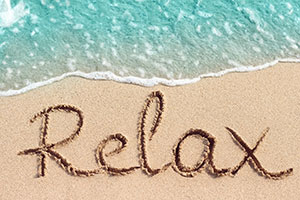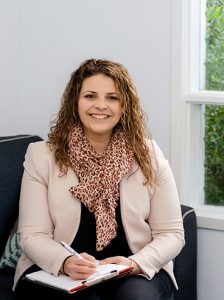Incorporating relaxation into everyday life

Many of us struggle to unwind and relax. We can often get caught up in the busy nature of life, that we forget to take time for ourselves and allow our body and mind to recover. Relaxation is a vital part of maintaining a good level of emotional wellbeing, reduction in blood pressure, increased energy levels and can reduce absenteeism from work, study, and susceptibility to the common cold.
When you think about ‘relaxation’ you may envision sitting or meditating for long periods of time. This can be a deterrent for some and lead to dread and avoidance. Spending as little as 10 minutes a day can be beneficial and is likely to be achievable for most individuals.
There are many forms of relaxation. Below are a few you may wish to try:
Breathing techniques
- Diaphragmatic/deep breathing: sitting up straight, place one hand on your chest and the other hand on your abdomen. Take a slow deep breath, inhaling through the nose for approximately 4 seconds, hold that breath momentarily, then exhale slowly through your mouth for 6 seconds. Repeat for a count of 3. As you feel more comfortable with this technique, try to stay engaged in this breathing relaxation for longer periods of time.
- Square/Box breathing: sitting up straight, inhale slowly and deeply through your nose for 4 seconds feeling the air completely fill your lungs and moving into the abdomen, hold that breath for four seconds, exhale slowly through your mouth for 4 seconds, pause for 4 seconds, and repeat.
Progressive muscle relaxation
This technique involves tensing and relaxing various muscles in the body. Starting with your feet, tense your toes for 5 seconds and then allow the muscles to relax for 10 seconds. Next tense your calves (being careful not to tense too much as this part of the body is susceptible to cramping!) for 5 seconds and then relax the muscles for 10 seconds. Continue to follow this process whilst you work through your body, from your thighs, hips, chest and stomach, shoulders, upper back, neck, arms and face. Follow the below link for a guided outline. https://www.cci.health.wa.gov.au/~/media/CCI/Mental%20Health%20Professionals/Panic/Panic%20-%20Information%20Sheets/Panic%20Information%20Sheet%20-%2005%20-%20Progressive%20Muscle%20Relaxation.pdf
Mindfulness
Mindfulness is noticing and being aware of the present moment. It’s about paying attention to our thoughts, feelings, and sensations in our body.
Sensory exercise
- Take 30 seconds to focus on your breathing. You may wish to utilise one of the breathing techniques listed above.
- Sight: look around and name 5 objects
- Touch: look at and touch 4 different objects. Notice their texture, weight and temperature
- Sound: notice 3 sounds
- Smell: identify 2 smells, paying attention to the aroma
- Taste: notice 1 thing you can taste.
Body scan
- Close your eyes and gently bring your awareness to your breathing. Spend 30 seconds focusing on your breathing, not changing it in anyway, just noticing your natural breath and how your chest rises and falls with each breath you take.
- If you notice your mind begins to wander and you start thinking of other things, remember that this is completely natural and okay. Just gently notice your thoughts, without getting caught up in them, and bring your awareness back to your breathing.
- Begin the body scan by noticing your feet. Notice how your feet feel in your shoes and against the floor. Pay attention to all sensations such as temperature, pressure, tingling or weight.
- Continue the body scan by noticing each part of your body; legs, hips, chest and stomach, shoulders, upper back, neck, arms and face.
- Return your awareness to your breathing. Noticing your chest rising and falling, as you breathe in and out. Open your eyes.
*You may wish to do a variation of this exercise. Follow steps 1 and 2 as above, and when you reach step 3, as you begin to notice sensations in your body, imagine a warm glow of light. Starting at your toes, work your way up your body, imagining that this warm light radiates warmth and comfort.
- Guided mindfulness meditation
Mindfulness apps are a great tool to utilise as they provide guided meditations you can engage in throughout the day. I recommend Smiling Mind. Why? Well it’s a free app, no ads, no junk emails/spam sent to your inbox, and offers ample meditation clips, starting from 1 minute! So, for those of you who are time poor, there is sure to be a guided meditation here for you. There are plenty of great apps out there, which require you to purchase the app or to subscribe, and it is totally up to you if you choose to look into these.
- Mindful colouring
Mindful colouring is a great way to relax and unwind. Mindful colouring is not just about colouring in a picture or pattern, rather it is about paying attention and noticing the process of the colouring. Notice the feel of the marker or pencil in your hand. Pay attention to each stroke, the pressure you apply, the movement of your hand as you colour in the image, and the sound made as your marker/pencil touches the paper. Adult colouring books are available from local bookstores, department stores and your local supermarket may stock some. When searching for a mindful colouring book, go with the one whose patterns or images are most appealing to you.
Relaxation doesn’t always have to entail a process. It can also be seen as engaging in enjoyable activities such as having a bath, reading a book, or going for a walk. Try to do these activities mindfully, with openness and curiosity, paying attention to the present moment.
Remember, practice and consistency is key to establishing relaxation in your daily schedule!
About the Author:

